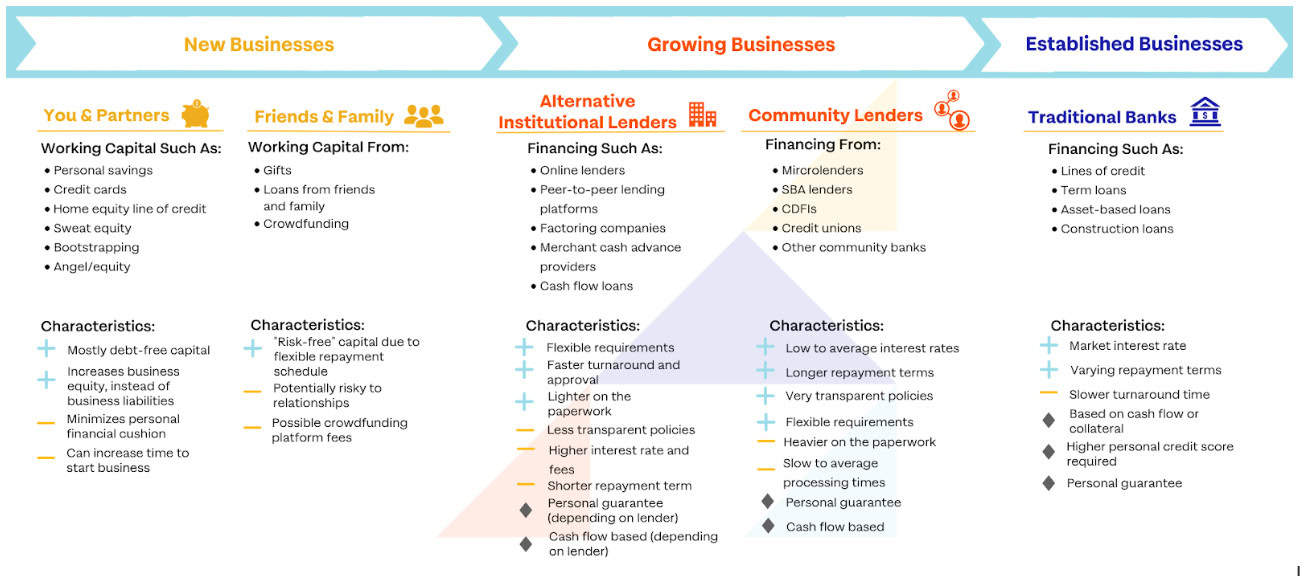Business Loans for Women Small Business Owners – The Best Options and Insights to Scale Your Business
Choosing the right lender is vital for women small business owners on the path to growth.

The lending landscape presents unique challenges for female-owned businesses, including lower loan approval rates, limited access to credit, and increased vulnerability to predatory lending.Understanding the lending landscape is crucial for effectively navigating your funding options.Key Takeaways:
- Choose the Right Lender: Selecting a lender who aligns with your business goals and values is essential for growth and sustainability.
- Understand the Lending Landscape: Women face unique challenges, such as lower loan approval rates and limited access to credit. Familiarizing yourself with different lenders can help you navigate these challenges effectively.
- Explore Diverse Funding Options: From traditional banks and credit unions to online lenders and community development financial institutions (CDFIs), various funding sources cater to different needs.
- Prepare Essential Documentation: Gather key documents including financial statements, tax returns, and a business plan to enhance your loan application credibility.
- Know the 5 C’s of Credit: Character, Cash Flow, Capital, Collateral, and Conditions are crucial factors lenders consider when assessing your creditworthiness.
- Beware of Predatory Lending: Stay vigilant against lenders offering unclear terms, hidden fees, or aggressive tactics. Always ensure transparency in loan agreements.
- Leverage Community Resources: Networking with other women entrepreneurs and seeking mentorship can provide invaluable insights and opportunities for funding.
- Educate Yourself: Empowerment through knowledge about financing, loan terms, interest rates, and repayment schedules equips you to make informed decisions for your business’s financial future.
Understanding the Lending Landscape
For women small business owners, navigating the lending landscape is crucial to securing the funding necessary for your growth and sustainability.An ideal financial partner provides essential capital, aligns with goals and values to facilitate expansion and resilience in challenging times, and supports business owners holistically through education and coaching.Understanding the various types of lenders available can empower you to make informed decisions that align with your unique business needs. Different loan programs cater to a wide range of financial needs and businesses, so consulting with lenders to find the most suitable program for your circumstances is essential.
Understanding Business Loans for Women
As a woman small business owner, accessing capital to grow your business can be a challenge. Understanding business loans and the options available to you is crucial to making informed decisions about your business’s financial future. In this section, we will explore the different types of business loans available to women, the benefits and drawbacks of each, and provide tips on how to navigate the loan application process.
Funding Options to Start and Grow Your Business
Funding can come from a variety of sources, including personal savings, loans, grants, and investors. It’s vital to identify which type of capital best fits the unique needs of your business. Understanding the loan term is crucial when evaluating different funding options, as it affects your future financial commitments and obligations, including your business’ cash flow.Accessing capital is crucial for women small business owners as they work toward growth and sustainability. Understanding the various funding options and being well-prepared is essential to securing the necessary financing.
Various Types of Lenders – What To Know
Traditional Banks
These institutions are well-established and offer a wide range of loan products. They tend to have strict eligibility requirements and longer application processes, which can be challenging for some small business owners . However, if you have a solid business plan, in most cases at least two years in operation, and good credit, traditional banks can provide reliable financing. With all loans, it is crucial to thoroughly review all loan documents to ensure you understand the terms and can avoid any potential predatory lending practices.
Credit Unions
Often seen as more community-focused, credit unions are nonprofit institutions that serve specific demographic groups, like their local area, military veterans, or professional associations and to qualify for a small business loan you need to be a member. They typically offer lower interest rates and more personalized service compared to traditional banks, making them an excellent option for women business owners who prioritize community support.Additionally, credit unions provide a variety of loan programs tailored to meet diverse financial needs, which can be highly beneficial for businesses seeking specific funding solutions. These include:
- Equipment Financing: Loans specifically designed to purchase or lease essential equipment for the business.
- Commercial Real Estate Loans: Financing options for purchasing or refinancing commercial properties.
- Business Lines of Credit: Flexible funding that allows businesses to draw on funds as needed, ideal for managing cash flow fluctuations.
- Microloans: Smaller loan amounts aimed at helping startups and small businesses that may not qualify for traditional financing.
- SBA Loans: Partnerships with the Small Business Administration to provide guaranteed loans with favorable terms for qualifying businesses.
- Inventory Financing: Loans designed to help businesses purchase inventory, allowing them to stock up without straining their cash flow.
- Working Capital Loans: Short-term loans to help businesses cover day-to-day operational expenses.
Online Lenders
Known for their fast and convenient application processes, online lenders can provide quick access to funds. They often utilize technology for underwriting, which can be beneficial for small business owners needing rapid financing. However, understanding the loan terms and interest payments is crucial when dealing with online lenders, as these factors significantly impact your financial commitments. Please be vigilant about comparing terms, as their interest rates can vary widely and aren’t always reported in terms of APR, which makes them difficult to compare with other offers.
Community Development Financial Institutions (CDFIs)
CDFIs are dedicated to serving underinvested markets, including women-owned businesses. They often provide mentoring and resources tailored to help you succeed in your business journey besides access to capital.Additionally, CDFIs offer a variety of loan programs that cater to different financial needs, making them a valuable resource for women-owned businesses seeking suitable funding options. Some CDFIs (like AOF) are digital first, which means that they offer online loan application processes presenting diverse loan offers and transparent terms.
Peer-to-Peer Lenders
This innovative funding model connects you directly with individual investors through online platforms. While these lenders can offer favorable terms, it’s essential to understand the importance of the loan term and interest payments when dealing with peer-to-peer lenders. Additionally, researching and choosing reputable platforms is crucial to avoid potential pitfalls.Popular platforms include:
- Kiva: A platform that allows individuals to lend money to low-income entrepreneurs and students in over 80 countries.
- Kickstarter: A crowdfunding platform that enables creators to fund their projects by receiving contributions from backers.
These platforms provide opportunities for businesses to access funding directly from investors, often with unique terms compared to traditional lenders.
Key Considerations When Choosing a Lender
Small businesses may be denied a loan because of bad credit, an unstable business industry, or borrowing below the loan amount threshold set by traditional lenders, like banks.Alternative lending provides additional options. Each type of lender comes with its own benefits and drawbacks.By understanding these different types of lenders, you can better position yourself to find the right financing solutions that support your aspirations and goals as a woman business owner.When selecting a lender, you should consider several key factors to ensure that the partnership aligns with your goals and financial needs. You also need to look for lenders that comply with federal law, which mandates necessary disclosure forms to be sent to loan applicants, ensuring transparency and legal compliance during the loan application process.
- Reputation and Reliability: Before anything else, assess the lender’s reputation in the market. Look for reviews, testimonials, and any warnings from other borrowers. A lender with a solid track record of ethical practices and positive customer service is more likely to provide a satisfactory experience.
- Financial Health and Lending Criteria: Assessing the lender’s financial stability is crucial as it can impact your loan experience. Start by reviewing the lender’s overall reputation and customer feedback to ensure reliability. Look into their lending criteria, such as credit score requirements, debt-to-income ratios, required financial documents, and overall income. Understanding these criteria can help you identify which lenders are more likely to approve your application and offer you the most favorable terms, allowing you to make informed decisions before you ever apply (and receive a hard credit pull).
- Loan Types and Repayment Terms: Different lenders offer various loan products, including long-term loans, short-term loans, lines of credit, and more. Evaluate the types of loans available to choose one that fits your business model and cash flow needs.
- Consider the repayment terms: interest rates, origination fees, payment schedules, and any potential penalties for late or early payments. A clear understanding of these terms will enable you to manage repayments effectively and avoid future financial strain.
What Documentation Do You Need to Get a Loan?
To effectively access the capital needed to achieve your business goals, follow these steps:
Prepare Necessary Documentation:
- Gather essential documents, including:
- Business Financials:
- Financial statements (profit and loss statements)
- Tax returns
- Bank statements
- Business Plans and Forecasts:
- A comprehensive business plan outlining your goals, strategies, and financial projections
- Business Financials:
Understand Your Credit Score:
- Your credit score significantly influences your ability to secure financing.
- Lenders use your credit score to assess their risk when lending to you.
- To improve your credit score before applying:
- Pay down existing debtsMake timely payments
- Address any errors in your credit report
- A better credit score can lead to improved loan terms and accessibility.
- Pay down existing debtsMake timely payments
Assess Your Business Stage:
- Understanding where your business stands is critical for selecting appropriate funding options.
Choose Reputable Lenders:
- Research lenders to ensure they have a solid reputation.
- Look for reviews and ratings to gauge the experiences of other borrowers.
By following these steps, you can enhance your credibility with potential lenders and streamline your loan application process.
Consider the resources available at each stage.
Start-ups may rely heavily on personal savings, friends, and family for initial funding. Established businesses might qualify for loans from community banks and credit unions. Alternative lenders may help fill gaps for growing businesses, but be cautious of their terms and ensure they align with your long-term goals.
Review the Terms and Conditions of your Potential Loans
When choosing a lender, it’s essential to carefully review the terms and conditions of any loan agreement to ensure it aligns with your business needs.
- Balloon Payment: This is a specific type of payment that comes at the end of a loan. It’s usually much larger than the regular payments you made before. This can change how you manage repayments over time.
For funding, here’s how various businesses might find help:
- Start-ups: These businesses often rely on personal savings, along with money from friends and family, to get started.
- Established Businesses: Once a business is up and running, it might qualify for loans from community banks and credit unions, which can provide more support.
- Alternative Lenders: For businesses that are growing, these lenders can help fill in the financial gaps. However, it’s important to be careful and check that their loan terms match your long-term goals.
Interest Rates vs. APR
Understanding the difference between interest rates and the Annual Percentage Rate (APR) is critical. Here’s a breakdown:
Interest Rate:
- This is the cost you pay each year to borrow money.
- Expressed as a percentage of the loan amount.
- May be reported as daily, weekly, monthly, or annual rates.
Annual Percentage Rate (APR):
- This includes the interest rate plus any additional fees or costs associated with obtaining the loan.
- Provides a more comprehensive view of the total cost of borrowing over a year.
Interest Paid:
- Refers to the total amount of interest a borrower pays over the course of a year.
- This is indicated in the IRS 1098 Mortgage Interest Statement.
- Has significant financial implications for borrowers and their tax obligations.
When comparing these two rates:
- The interest rate gives you a basic idea of borrowing costs, but it does not account for additional fees, so it may appear lower than the actual cost.
- The APR, being annualized, provides a clearer picture of what you’ll actually pay for the loan, including all fees.
Be cautious: if a lender does not provide the APR and clearly list all fees, it may indicate predatory lending practices. Always compare both rates to understand the true cost of borrowing and protect yourself from unfavorable loan terms.
Understanding Loan Repayment Schedules
Familiarizing yourself with your loan’s repayment schedule is essential. Here’s a breakdown of important terms and concepts:
Principal Balance:
- The amount of debt remaining on a loan, excluding interest.
- Crucial for understanding your loan agreement and repayment schedule.
Repayment Schedule:
- Details the frequency and amount of payments you need to make until the loan is fully paid off.
- Common payment frequencies may include:
- Monthly
- Bi-weekly
- Weekly
- Amortization:
- This means breaking down your loan into a series of regular payments over time.
- The process of spreading out a loan into a series of fixed payments over time.
- Each payment typically covers both principal and interest, gradually reducing the principal balance.
- This means breaking down your loan into a series of regular payments over time.
Understanding these terms is critical as they relate to your business metrics:
- Cash Flow Management: Knowing your repayment schedule allows for better cash flow management. It ensures that you have enough funds available to make timely payments without disrupting daily operations.
- Impact on Revenue and Profit: Accurate forecasting of loan repayments helps you align your business revenues and expenditures. This planning can assist in ensuring that profits are retained for business growth rather than being depleted by unexpected repayment obligations.
By recognizing how loan repayment schedules impact your finances, you can make informed decisions that support your business’s overall financial health and sustainability.
Importance of Clear Communication and Transparency
Ensuring that your lender communicates clearly and transparently is vital. You should have a thorough understanding of your loan terms, including any fees, penalties, and repayment options. Reputable lenders are willing to provide detailed explanations, answer all your questions, and offer documentation outlining all aspects of the loan. Open communication helps prevent misunderstandings and potential financial pitfalls in the future. Before applying for a loan, be sure to ask questions of potential lenders to understand their application and loan repayment process. This will help you know what they are looking for in loan applicants and ensure you are well-prepared. Additionally, keep documentation of your communications for reference throughout the loan process.
Key Questions to Ask When Seeking Funding
When seeking funding for your business, it is essential to ask yourself and potential lenders the right questions to ensure any capital you receive aligns with your needs and goals. Consider the following key questions…
Questions to Ask Yourself:
What do you need the money for?
- Clearly define the purpose of the funds, whether for start-up costs, operational expenses, or growth initiatives. This understanding helps you choose the most suitable financing options.
How much money do you need?
- Be realistic about the amount required. Consider both immediate expenses and future capital needs. Thorough calculations help prevent underfunding or overborrowing.
How quickly do you need the money?
- Determine your timeline for obtaining funds. Some financing options may take longer to process than others, so understanding your urgency can guide you toward the right lender and product.
- It’s crucial for small business owners to recognize the importance of applying for a loan before they find themselves in urgent need of funds. Waiting until a cash crunch arises can limit options and lead to hasty decisions that may not align with their best interests. By proactively exploring financing solutions and applying when you do not urgently need the capital, you allow for better planning, improved terms, and the opportunity to secure funding that’s right for your business, ultimately contributing to your long-term success. Understanding this key principle can transform how small businesses navigate their financial landscapes.
Questions to Ask Potential Lenders:
What are the interest rates and fees associated with the loan?
- Understanding the total cost of borrowing is crucial. Ask for a breakdown of all costs involved.
What is the repayment schedule?
- Inquire about the frequency and amount of payments. This knowledge helps you plan your cash flow effectively.
Are there any penalties for early repayment?
- Knowing whether there are any fees for paying off the loan early can influence your decision.
What are the requirements to qualify for this loan?
- Ask about the application process, credit score requirements, and any necessary documentation.
How long will it take to process the loan?
- Understanding the timeline can help you manage your expectations and financial planning.
Can you provide references from other borrowers?
- Speaking with other customers can give you insight into the lender’s service, reliability, and transparency.
By asking these questions, you can gain a deeper understanding of your funding options and ensure that both your needs and those of the lender align effectively.
Predatory Lending
Predatory lending refers to the practice of imposing unfair and abusive loan terms on borrowers. This can manifest in several ways, such as using deceptive language that obscures unfavorable rates, or extending loans to individuals who are unable to qualify for traditional financing due to poor credit history.Predatory lending is a serious concern for small business owners. Women small business owners often face difficulties in securing loans from traditional banks, they may turn to alternative sources that have predatory lending practices, which can be detrimental to their business growth. Inadequate income can make borrowers vulnerable to predatory lending practices, as businesses with lower revenue are more likely to face urgent cash needs, leading them to seek loans from predatory lenders who exploit their limited options and financial need.Lenders may present offers that seem appealing at first glance but can include hidden fees and costs, ultimately jeopardizing the borrower’s financial stability. Additionally, interest rates may not be clearly represented as APR (Annual Percentage Rate), which can obscure the true cost of borrowing and lead to financial strain for the borrower.
How to Recognize and Avoid Predatory Lenders
To protect your business from falling victim to predatory lending practices, be vigilant for the following warning signs:
- Unclear Pricing and Terms: If fees and interest rates are not clearly presented or are difficult to understand, this may indicate a lack of transparency designed to confuse borrowers.
- Aggressive or Abusive Broker Practices: Watch out for brokers who pressure you into accepting a loan or do not fully disclose additional fees.
- Prepayment Penalties: Be cautious of lenders who impose significant fees for paying off a loan early, which can trap you in a cycle of debt.
- Easy Approval: If a lender offers fast approval with little documentation required, this lack of due diligence could signify a predatory practice.
- Abnormal Payment Structures: Payment arrangements that vary from week to week or are based on a percentage of daily sales can complicate cash flow management.
- Short-Term Loans: Loans that require repayment within a short timeframe, such as payday or title loans, often come with exorbitant fees and terms.
- Difficulty in Communication: If the lender is hard to contact or dodges questions about terms and costs, this is a major red flag.
To safeguard your business, it is crucial to seek financing from reputable institutions such as traditional banks, credit unions, or accredited microlenders, as they typically adhere to regulatory standards that provide protections for borrowers.By remaining informed and vigilant, you can avoid predatory lending practices and secure the funding necessary for your business’s success.With an awareness of predatory lending practices, it is equally important to understand the specific terms and conditions associated with any loan you consider. Careful scrutiny of these terms will help ensure that the loan aligns with your business goals and financial situation. If you don’t understand something in a loan contract, keep asking questions until you have a full picture of what you are signing up for, before you sign the contract. Reputable lenders should be willing to answer all of your questions before you sign.
Challenges Faced by Women Entrepreneurs and Minority-Owned Firms
Women and minority-owned firms often face significant barriers when seeking funding. These include discrimination in lending practices, limited credit histories, and inadequate access to traditional financial networks. Such barriers can complicate the process of obtaining necessary capital. Challenges in obtaining a mortgage loan can further exacerbate these issues, making it even more difficult for these firms to secure the funding they need.
- Typically Smaller in Size, Starting with Less Capital: Many women entrepreneurs begin their businesses with limited financial resources, making it harder to qualify for larger loans.
- Lower Approval Rates for Bank Loans: Studies show that women and minority entrepreneurs have lower approval rates for traditional bank loans compared to their male or non-minority counterparts.
- More Vulnerable to Predatory Lending: Due to a lack of access to mainstream financing, these entrepreneurs are at higher risk of falling victim to predatory lending practices, which can impose unfair and abusive loan terms.
Understanding these challenges is crucial for women and minority business owners as they navigate their funding options. By asking the right questions and being aware of the barriers, you can better position your business to secure the necessary capital.
Solutions and Strategies to Overcome Barriers
Women entrepreneurs can build a solid financial foundation to mitigate these challenges, leverage community resources, and explore alternative funding options such as microloans or Community Development Financial Institutions (CDFIs). Networking with fellow female business owners can also reveal invaluable opportunities and insights.Establishing connections with mentors and other entrepreneurs is crucial for success. Mentorship provides guidance and support, while networking opens doors to funding sources and collaborative ventures. Engaging with a community of like-minded women allows for the exchange of experiences and resources, strengthening your business journey.
The 5 C’s of Credit
In addition to understanding documentation and business stages, it’s important to familiarize yourself with the following key topics:The 5 C’s of Credit: Lenders typically evaluate your creditworthiness based on five factors:
Character:
- This refers to your credit history and reliability in repaying debts.
- Example: This includes your credit score and credit report, which show how well you’ve managed your previous loans.
Cash Flow:
- This is the revenue available to repay the loan.
- Example: It’s shown in your bank statements and reflects how your income compares to your other debts or loans.
Capital:
- This is the amount of personal investment you have made in your business.
- Example: This includes how much money you have personally put into your business to get it started or help it grow.
Collateral:
- These are the assets you pledge as security for the loan.
- Example: This could be things like real estate, vehicles, or major equipment that you own.
Conditions:
- These are external factors that could impact your business success.
- Example: This might include the current state of the economy, the outlook for your industry, and any regulations that could affect your business.
By understanding these five factors, you can better prepare yourself for discussions with lenders and improve your chances of securing the funding you need.
Empowerment Through Knowledge and Community Support
Choosing the right lender extends beyond merely obtaining funds; it involves finding a partner who aligns with your business vision and understands your goals. Strategic lender selection, characterized by fair terms and transparency, can pave the way for sustained growth. Most importantly, it’s about finding the right match for your business and your specific needs. This ensures that the financial support you receive is conducive to your success and long-term objectives.Empowering yourself with knowledge and utilizing community support creates a strong foundation for success. This empowerment enables women business owners to tackle challenges confidently and excel.As you pursue funding for your business, we encourage you to engage with available resources, participate in educational events, and seek out the capital necessary for growth.Remember, you are part of a vibrant community of women entrepreneurs dedicated to uplifting one another. Your success is within reach.
The Importance of Educational Resources and Events
Education plays a vital role in understanding the financial landscape for women small business owners. By equipping yourself with the necessary knowledge, you can navigate the complexities of securing funding and make informed decisions that benefit your business.Gaining a solid understanding of financial principles is essential for women entrepreneurs. Education empowers you to comprehend loan terms, interest rates, and repayment structures, enabling effective engagement with lenders and better negotiation of loan agreements.We provide a wealth of resources to support your ongoing education, particularly in the area of lending, and we are eager to assist you in your journey toward business growth. If you have questions related to coaching or other support, please reach out to our dedicated team for assistance to ensure you receive the help you need.








